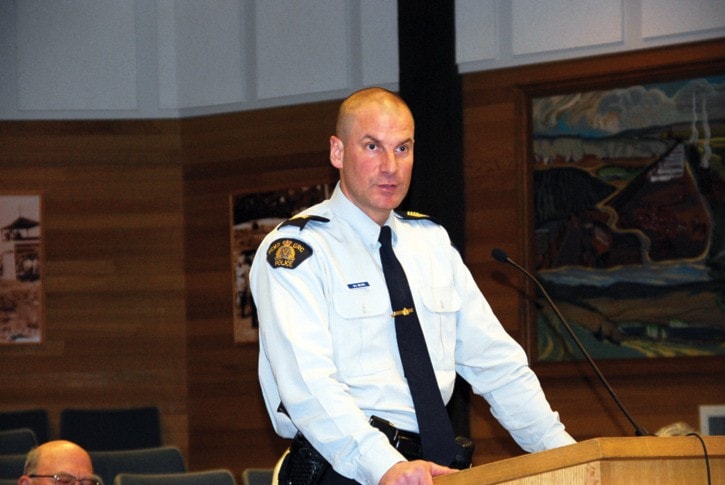Crime stats for 2011 in Williams Lake are on a steady decline, says the Williams Lake RCMP.
Compared to 2008 when the RCMP received 11,116 calls for service, in 2011 those dropped by 25 per cent to 8,372 calls.
That 25 per cent decline in calls is positive because the police officers are able to spend time actually investigating crimes, said Insp. Warren Brown of the Williams Lake RCMP during a presentation to city council Tuesday.
“You will notice we are more visible in the parks and on the streets,” Brown said, adding that Boitanio Park continues to be an area of concern. Brown broke the stats down for council, continuing with a comparison between 2008 and 2011.
Starting with auto thefts, which in 2011 were as low as they have ever been, Brown said there’s been a significant reduction.
In 2008, 60 autos worth more than $5,000 were stolen, compared to six in 2011. Thefts of autos worth under $5,000 numbered 66 in 2008, whereas only eight in that category were stolen in 2011.
Even a sharper decline occurred in the theft of trucks valued at more than $5,000. In 2008, 115 were stolen; in 2011, there were three.
For trucks valued under $5,000, 47 were taken in 2008 compared to four in 2011.
As far as break and enters to residences, in 2008 there were 152 and in 2011 there were 90, while break and enters to businesses totalled 82 in 2008 compared to 22 in 2011.
Acts of mischief were at 655 in 2008, down to 400 in 2011; robbery went from 41 in 2008 to 15 in 2011; and false alarms went from 878 in 2008 to 623 in 2011.
Brown said he anticipates the new false alarm bylaw will decrease those numbers further.
The one area where numbers are not declining is spousal assaults.
The numbers rose from 84 in 2008 to 94 in 2009. There was a decline in 2010 with 67, but in 2011, the number was back to 84.
“Right now, we’re status quo,” Brown told council. “That’s an area of concern for me.”
When Coun. Surinderpal Rathor said it concerns him the number of spousal assaults is climbing again, when other areas of crime are declining, Brown pointed out the statistics only reflect what’s being reported to police.
“It’s a very small percentage of what’s being reported to us. We have done studies along with other police departments.
“We look at the economy in the region, we look at the risk factors, the isolation, it’s something that we are trying to get our head around,” Brown said, adding the RCMP have implemented a program engaging crown counsel and victim services to help identify high-risk families.
Coun. Sue Zacharias echoed Rathor’s concerns and suggested spousal assaults can be difficult to target because on many occasions they are “in the closet” and aren’t always out in the public eye.
“Maybe that’s something we should think about, how we’re going to approach this because of issues around privacy, families, and shame,” Zacharias said, adding perhaps even churches and pastors could play a role because they also deal directly with families.
“It might be worth reaching out to another segment of the population and ask for help,” Zacharias said.
When asked by Coun. Danica Hughes if spousal assaults are occurring among a known demographic, Brown said they are happening in all communities — low income to high income families. “Income is no predictor; each trigger is different depending on specific circumstances.”
Hughes also asked if restorative justice helps whole families, and again Brown said there’s a good program in place, Circles of Violence, where community policing and other stakeholders are involved.
“We bring families together, crown does an assessment of risk, and they look at alternative measures. We’re one of several model sites for that in the province,” he said.
Brown said it’s often a matter of two steps forward and a few steps backward.
“It’s difficult because as you said, it is often behind closed doors, and I would suggest there are upwards of a hundred risk factors that could increase intensity for spousal assaults.”
He said street fights are also a concern because much of them are occurring among youth with the choice of weapons being bear spray and machetes.
That is an area where Brown hopes to get more youth engagement, to meet with the youth junior council and with youth in schools.
“We’ve had very good involvement and engagement with our First Nations communities and I feel we’re making progress, but it’s still a very daunting task ahead of us. We still have the highest ratio in B.C. for violent crimes,” Brown said.
